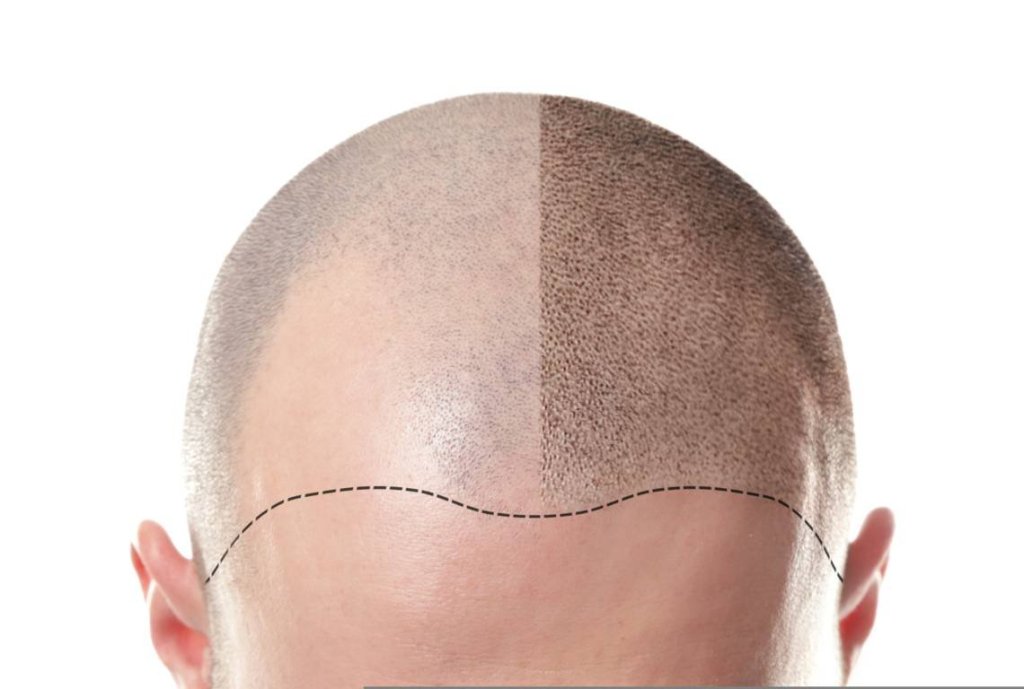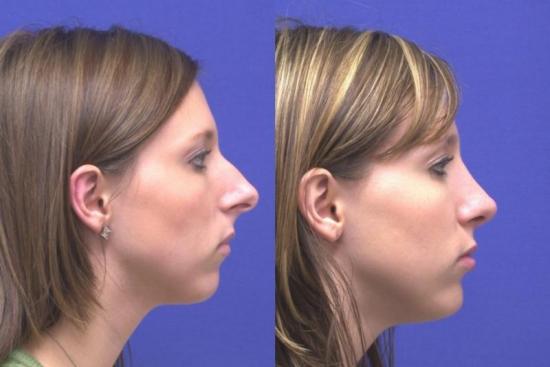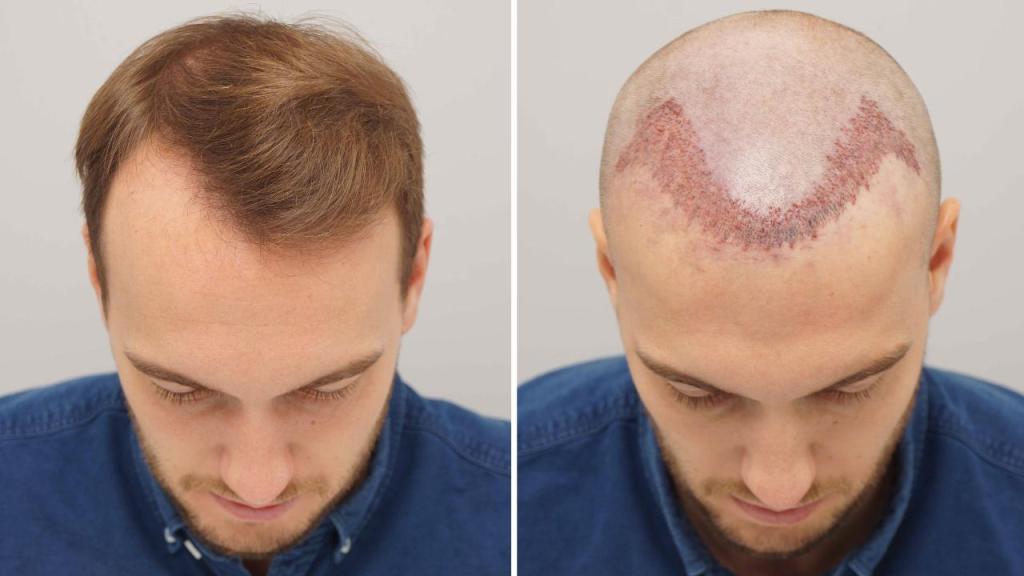What Is A Hair Transplantation?
A hair transplantation is a surgical procedure that involves removing hair follicles from one part of the body, known as the donor site, and transplanting them into another part, known as the recipient site. The most common type of hair transplantation is called follicular unit transplantation (FUT), where a strip of skin containing hair follicles is taken from the back or sides of the head and dissected into individual grafts. These grafts are then carefully inserted into small incisions in the recipient site.
A hair transplant can be a suitable option for individuals who are experiencing hair loss or baldness. However, it is important to consult with a qualified hair transplant surgeon to determine if you are a suitable candidate. Factors such as the extent of hair loss, the quality and quantity of available donor hair, and the overall health of the individual are all taken into consideration during the consultation process.
There are several different methods of hair transplantation, each with its own advantages and limitations. In addition to FUT, another commonly used technique is follicular unit extraction (FUE), where individual hair follicles are harvested directly from the donor site using a small punch tool. FUE is a more time-consuming and labor-intensive procedure compared to FUT, but it does not leave a linear scar and allows for a quicker recovery time.
Am I A Suitable Candidate For Hair Transplantation?
Before considering hair transplantation, it is important to determine if you are a suitable candidate for the procedure. Hair transplantation is a surgical technique in which hair follicles from one part of the body, known as the donor site, are transferred to a bald or thinning area of the body, known as the recipient site. This procedure is primarily used to treat male pattern baldness but can also be used in cases of female pattern baldness and other types of hair loss.
There are several factors to consider when determining if you are a suitable candidate for hair transplantation. One of the main factors is the extent of your hair loss. Hair transplantation is most effective in individuals who have a stable pattern of baldness and enough donor hair to achieve the desired results. If you have significant hair loss or very limited donor hair, you may not be a suitable candidate for the procedure.
Another important factor to consider is your overall health. Hair transplantation is a surgical procedure, and as with any surgery, it carries some risks. It is important to be in good general health before undergoing the procedure. Certain medical conditions, such as uncontrolled diabetes or autoimmune diseases, may make you ineligible for hair transplantation. It is important to discuss your medical history with a qualified hair transplant surgeon to determine if you are a suitable candidate.
What Are The Different Methods Of Hair Transplantation?
A hair transplantation is a surgical procedure that involves moving hair follicles from one area of the body, called the donor site, to a bald or thinning area of the body, known as the recipient site. This procedure is primarily used to treat male pattern baldness and involves different methods depending on the patient’s needs and preferences.
There are two main methods of hair transplantation: follicular unit transplantation (FUT) and follicular unit extraction (FUE). FUT, also known as the strip method, involves removing a strip of skin from the donor site, usually the back or sides of the scalp, and dissecting it into individual follicular units. These units are then transplanted into the recipient site.
On the other hand, FUE involves the extraction of individual follicular units directly from the donor site using a small punch tool. This method leaves tiny scars, known as puncture scars, which are less noticeable than the linear scars left by FUT. FUE is a preferred choice for patients who want to wear their hair short or are concerned about scarring.
- Both FUT and FUE have their advantages and disadvantages. FUT allows for the transplantation of a larger number of grafts in a single session, making it more suitable for patients requiring extensive transplantation. However, it leaves a noticeable linear scar and may have a longer recovery time.
- On the other hand, FUE does not leave a visible linear scar and has a quicker recovery time. Additionally, it provides more flexibility in terms of graft placement, allowing for a more natural-looking outcome. However, it may be more time-consuming and expensive compared to FUT.
| Method | Advantages | Disadvantages |
|---|---|---|
| FUT | – Allows for the transplantation of a larger number of grafts- Less expensive | – Leaves a noticeable linear scar- Longer recovery time |
| FUE | – Does not leave a visible linear scar- Quicker recovery time- More natural-looking outcome | – More time-consuming- More expensive |
Moreover, there are other variations of the FUE method, such as robotic hair transplantation and manual FUE. Robotic hair transplantation involves the use of a robotic system to extract and transplant follicular units, providing more precision and accuracy. Manual FUE, on the other hand, is performed solely by the surgeon using handheld instruments.
In conclusion, hair transplantation offers individuals with hair loss a chance to restore their natural hair. The different methods of hair transplantation, such as FUT and FUE, allow for both the transplantation of a larger number of grafts and a more natural-looking outcome. It is important for individuals considering hair transplantation to consult with a qualified surgeon who can assess their suitability for the procedure and recommend the most appropriate method.
How Long Does The Procedure Take?
When considering a hair transplantation procedure, one of the most common questions that individuals have is how long it will take. It is important to understand that the duration of a hair transplantation procedure can vary depending on several factors such as the extent of hair loss, the technique used, and the skill and experience of the surgeon. On average, a typical hair transplantation procedure can take anywhere from 4 to 8 hours.
During the procedure, the patient will be under local anesthesia to ensure their comfort throughout the process. The surgeon will harvest hair follicles, typically from the back or sides of the head, and transplant them to the areas with thinning or balding hair. While the procedure itself may take several hours, it is crucial to remember that proper planning and consultation with the surgeon beforehand is necessary to achieve optimal results.
Factors Affecting Procedure Duration
Several factors can influence the duration of a hair transplantation procedure. One of the main factors is the technique used. There are different methods of hair transplantation, including Follicular Unit Extraction (FUE) and Follicular Unit Transplantation (FUT). FUE is generally a meticulous and time-consuming process as each hair follicle is individually extracted and transplanted. On the other hand, FUT involves harvesting a strip of tissue from the donor area, which may require more time for suturing.
Additionally, the extent of hair loss plays a role in determining the duration of the procedure. Patients with significant hair loss may require a larger number of hair follicles to be transplanted, which can increase the overall time needed for the procedure. The skill and experience of the surgeon also contribute to the efficiency of the procedure. Experienced surgeons who specialize in hair transplantation can often perform the procedure more quickly and accurately compared to less experienced practitioners.
Conclusion
In conclusion, the duration of a hair transplantation procedure can vary depending on factors such as the technique used, the extent of hair loss, and the surgeon’s skill and experience. While the average duration is around 4 to 8 hours, it is important to consult with a qualified hair transplant surgeon to get a more accurate estimate based on your specific case. Remember that the success of the procedure depends not only on the duration but also on careful planning and individualized treatment to achieve the desired outcome.
What Are The Potential Risks And Side Effects?
When considering a hair transplantation procedure, it is important to be aware of the potential risks and side effects involved. Like any surgical procedure, there are inherent risks that should be thoroughly understood before making a decision. One of the potential risks is infection. Although rare, there is a possibility of infection at the site of the transplant, which can be treated with antibiotics if detected early. Another risk is bleeding. During the transplantation process, there is a chance of excessive bleeding, which may require additional medical attention.
In addition to these risks, there are potential side effects that patients should be aware of. One common side effect is swelling. After the procedure, it is not uncommon for the scalp to swell, especially around the forehead and eyes. This swelling usually subsides within a few days, but it is important to follow post-operative care instructions to minimize discomfort. Another potential side effect is scarring. While modern techniques aim to minimize scarring, it is still possible to develop small scars at the site of the donor and recipient areas. These scars are generally well-hidden by hair growth, but it is important to discuss any concerns with a qualified hair transplant surgeon.
Furthermore, there is a potential for numbness or lack of sensation in the donor and recipient areas. This is usually temporary and resolves over time, but patients should be aware of this possibility. Additionally, some patients may experience hair follicle shock loss. This occurs when the transplanted hair temporarily sheds after the procedure. It is a natural part of the healing process and the hair usually regrows within a few months.
| Potential Risks | Side Effects |
| InfectionBleeding | SwellingScarringNumbness or lack of sensationHair follicle shock loss |
In conclusion, while hair transplantation can be an effective solution for hair loss, it is important to understand and consider the potential risks and side effects involved. By discussing these concerns with a qualified hair transplant surgeon, individuals can make informed decisions and choose the right course of action for their specific needs and goals.
How Much Does A Hair Transplant Cost?
A hair transplant can be a life-changing procedure for those experiencing hair loss. But before deciding to undergo this treatment, it’s essential to consider the cost involved. The cost of a hair transplant can vary depending on various factors, such as the extent of hair loss, the technique used, the surgeon’s experience, and the geographical location. It is crucial to have a realistic understanding of the expenses involved to make an informed decision.
1. Technique: Different hair transplant techniques have different costs. The two most commonly used methods are follicular unit extraction (FUE) and follicular unit transplantation (FUT). FUE generally tends to be more expensive as it is a more advanced and time-consuming technique.
2. Extent of Hair Loss: The level of hair loss also plays a significant role in determining the cost. The more significant the hair loss, the more grafts will be required for transplantation. More grafts mean a higher cost.
3. Surgeon’s Experience: The experience and expertise of the hair transplant surgeon can significantly impact the cost. Highly experienced surgeons with a successful track record may charge higher fees. However, it is crucial to prioritize the surgeon’s skill and expertise over cost alone when making a decision.
4. Geographical Location: The cost of a hair transplant can also vary based on the geographical location. Procedures performed in metropolitan areas or well-known clinics may have higher costs compared to those in smaller towns or lesser-known clinics.
5. Additional Expenses: It’s essential to consider any additional expenses that may arise during the hair transplant process. These can include pre-operative tests, post-operative medications, and follow-up appointments. These costs may vary from clinic to clinic, so it’s vital to clarify them beforehand.
Conclusion: When considering the cost of a hair transplant, it’s important to remember that it is an investment in your self-confidence and overall well-being. While cost is a crucial factor, it should not be the sole determinant in choosing a clinic or surgeon. Opting for a reputable and experienced surgeon who provides personalized care and achieves natural-looking results should be the top priority.
What Is The Expected Outcome And Recovery Time?
What Is The Expected Outcome And Recovery Time? What Is The Expected Outcome And Recovery Time?
A hair transplantation is a surgical procedure that involves the redistribution of hair follicles from one area of the body to another. This procedure is mainly used to treat hair loss caused by various factors such as genetics, hormonal changes, or trauma. Hair transplantation is an effective and permanent solution for individuals seeking to restore their hairline and regain a fuller head of hair.
Before undergoing a hair transplantation, it is important to understand the expected outcome and recovery time associated with the procedure. The outcome of a hair transplantation depends on various factors including the technique used, the extent of hair loss, and the individual’s natural hair characteristics. It is crucial to have realistic expectations and to consult with a qualified hair transplant surgeon to determine the anticipated results based on your specific case.
The recovery time after a hair transplantation can vary depending on the individual and the technique used. Generally, the initial recovery period lasts for about 1 to 2 weeks, during which the scalp may be tender and there may be minor swelling. It is advised to take proper care of the transplanted area to ensure optimal healing and growth of the newly transplanted hair follicles.The expected outcome of a hair transplantation is the restoration of a natural-looking hairline and increased hair density in the recipient area. The transplanted hair follicles will initially shed within a few weeks, but new hair growth should gradually start within a few months. It is important to note that the full results of a hair transplantation may take up to a year to become apparent.
| Potential Risks and Side Effects | Post-Operative Care Instructions | Alternatives to Hair Transplantation |
|---|---|---|
| It is essential to be aware of the potential risks and side effects associated with hair transplantation. These can include infection, bleeding, scarring, and numbness in the donor and recipient areas. However, when performed by a qualified and experienced surgeon, the risk of complications is minimal. | After a hair transplantation, the surgeon will provide detailed post-operative care instructions. These may include guidelines on how to wash the hair, avoid strenuous activities, use medication to promote healing, and protect the scalp from sun exposure. Following these instructions diligently can significantly contribute to a successful recovery. | In some cases, individuals may consider alternative options to hair transplantation. These can include non-surgical hair restoration treatments, such as medication or low-level laser therapy. However, it is important to note that these alternatives may not provide the same permanent and natural-looking results as a hair transplantation. |
What Are The Post-Operative Care Instructions?
After undergoing a hair transplantation procedure, it is crucial to follow proper post-operative care instructions to ensure optimal healing and successful results. These care instructions are designed to minimize the risk of complications, promote hair growth, and enhance the overall outcome of the procedure. Here are 10 important questions to ask and aspects to consider regarding post-operative care:
- How should I cleanse my scalp and hair after the surgery?
- Are there any specific products or shampoos I should use?
- Can I resume my normal hair care routine immediately?
- When can I start washing my hair normally?
- Should I avoid any activities or exercises that may impact the transplanted area?
- Are there any dietary restrictions I should follow?
- What are the signs of infection that I need to watch out for?
- When can I expect to see initial hair growth?
- What are the common side effects during the healing period?
- When should I schedule my follow-up appointments with the surgeon?
The answers to these questions may vary depending on the specific instructions given by your hair transplant surgeon. It is important to discuss these care instructions thoroughly with your surgeon before and after the procedure, as proper care plays a crucial role in the success of the transplantation.
| Key Points to Remember |
|---|
| 1. Follow the specific cleansing instructions provided by your surgeon for the scalp and hair. |
| 2. Use the recommended products and shampoos to promote healing and hair growth. |
| 3. Gradually resume your normal hair care routine as advised by your surgeon. |
| 4. Be cautious of activities or exercises that may harm the transplanted area. |
| 5. Discuss any dietary restrictions or supplements with your surgeon for optimal healing. |
| 6. Be vigilant for signs of infection, such as redness, swelling, or discharge. |
| 7. Initial hair growth typically occurs within a few months after the procedure. |
| 8. Some common side effects include swelling, scabbing, and temporary shock loss. |
| 9. Schedule regular follow-up appointments with your surgeon to monitor progress. |
| 10. Consult your surgeon promptly if you have any concerns or questions during the recovery period. |
By carefully adhering to the post-operative care instructions provided by your hair transplant surgeon, you can ensure the best possible outcome and enjoy the long-term benefits of your hair transplantation.
Are There Any Alternatives To Hair Transplantation?
For individuals experiencing hair loss or thinning, hair transplantation may seem like the only solution. However, it’s important to know that there are alternative treatments available that can help address hair loss concerns. While hair transplantation is a widely sought-after procedure due to its effectiveness, there are several non-surgical alternatives that individuals can explore before considering transplantation. These alternatives aim to stimulate hair growth and improve the overall appearance of the hair without the need for surgical intervention.
One alternative to hair transplantation is medication. There are a few FDA-approved medications that have been proven to help slow down hair loss and promote hair regrowth. One common medication is minoxidil, which is applied topically to the scalp. Another medication, finasteride, is available in oral form and is only suitable for men. These medications work by either stimulating hair follicles or blocking the production of a hormone that contributes to hair loss. It’s important to consult with a healthcare professional before starting any medication to determine if it is a suitable option for you.
In addition to medication, another alternative to hair transplantation is low-level laser therapy (LLLT). LLLT is a non-invasive treatment that uses red light wavelengths to stimulate hair growth. The red light energy is believed to improve blood circulation and promote the activity of hair follicles. LLLT devices are available in various forms, such as combs or caps, which can be used at home. While the effectiveness of LLLT may vary among individuals, it is considered a safe and convenient alternative to surgery.
Another non-surgical alternative to hair transplantation is the use of hairpieces or wigs. These can be an excellent solution for individuals who are not suitable candidates for transplantation or prefer a temporary solution. Hairpieces and wigs come in a wide range of styles and materials, allowing individuals to find a natural-looking option that suits their needs. It’s important to choose a reputable supplier and ensure proper maintenance to achieve a natural appearance and avoid any potential discomfort.
Although hair transplantation is a highly effective and permanent solution for hair loss, exploring non-surgical alternatives can be beneficial for those who are not ready for or do not require surgical intervention. Medication, low-level laser therapy, and the use of hairpieces or wigs are just a few examples of the alternatives available. Consulting with a hair loss specialist can help determine the most suitable alternative for each individual, taking into consideration factors such as the cause and extent of hair loss, overall health, and personal preferences.
How Can I Choose The Right Hair Transplant Surgeon?
When considering a hair transplantation procedure, one of the most important factors to consider is choosing the right surgeon. This decision can significantly impact the final outcome and satisfaction with the results. Here are 10 important questions to ask before making a decision:
- What is the surgeon’s experience in hair transplantation? It is essential to inquire about the surgeon’s experience in performing hair transplantation procedures. Look for a surgeon who has specialized training and a significant number of successful procedures under their belt.
- What is the surgeon’s educational background? Knowing the educational background of the surgeon can provide insight into their qualifications and expertise. Look for a surgeon who has received training and certification from reputable institutions.
- What is the surgeon’s success rate? Inquire about the surgeon’s success rate in achieving natural-looking results and hair growth. A high success rate indicates the surgeon’s expertise and competence in the field.
The right hair transplant surgeon should have a solid understanding of the various hair restoration techniques available. They should be able to discuss the pros and cons of different methods, including follicular unit extraction (FUE) and follicular unit transplantation (FUT). This knowledge will enable them to recommend the most suitable approach based on your specific needs and expectations.
Additionally, it is crucial to assess the surgeon’s communication and interpersonal skills. A good surgeon should listen to your concerns, answer your questions, and provide clear explanations about the procedure and its potential outcomes. They should be approachable, empathetic, and able to establish a rapport with you, ensuring a positive and supportive patient-surgeon relationship.
Before making a final decision, it is essential to seek out testimonials and reviews from previous patients. Reading about other patients’ experiences can provide valuable insights into the surgeon’s reputation and the quality of their work. You can also request before and after photos to assess the surgeon’s aesthetic abilities.
In conclusion, choosing the right hair transplant surgeon is a crucial step in achieving a successful and satisfactory outcome. By asking the right questions, assessing the surgeon’s experience, understanding their communication skills, and reviewing testimonials, you can make an informed decision and ensure the best possible results.




Leave a comment